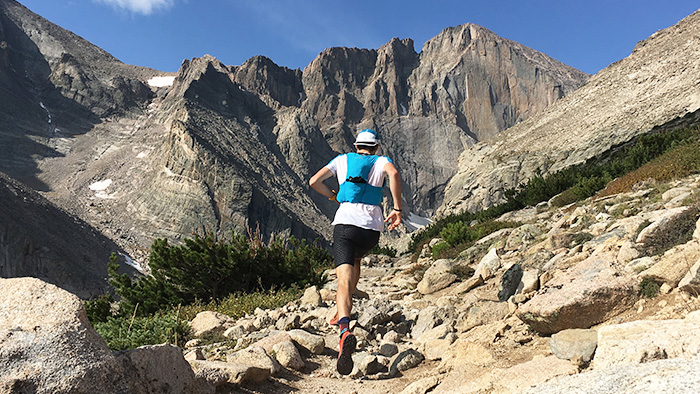It will come as no surprise that average running speed is slower on a hilly route than on a flat run, even when the start and finish are at the same elevation, or when there’s an equal amount of climbing and descending.
This is because downhill running pace is not fast enough to offset the slowing effect of climbing. One study identified that athletes ran, on average, 23% slower uphill and 13.8% faster downhill compared with their speed on flats, with speed changes primarily caused by decreasing stride length on the uphills.
To increase running speed on level terrain, runners typically increase stride length more than stride frequency. But it has been shown that, depending on the gradient of the slope being climbed, that cadence and step length alter. That is, a steeper gradient results in a higher step frequency, but shorter step length.
Step frequency can be increased with training, and research focuses on increasing cadence both when running on flat and on a gradual uphill. Interestingly, the uphill test resulted in not only an increase in steps per minute, but also a slight increase in step length.
More recent research investigating the impact of running an undulating trail highlighted that, on a two-loop course, the subjects slowed on average from a time of 19:40 on lap 1 to 21:08 on lap 2. The greatest time loss was on the uphill sections between lap 1 and lap 2.
The research suggests that if you were doing a race with multiple hills, e.g. an undulating half marathon which featured 1/3 uphill of climbing, 1/3 flat and 1/3 downhill, then more than 1/3 of your total run time would be spent climbing, as you will be moving slower uphill than on the flat and downhill sections. Furthermore, you will experience a greater slowing down in pace on the later hills in the race as you fatigue, compared to the flat and downhill sections.
Training for hill climbing certainly demands some focus. The research suggests that proficient uphill running can improve average running speed, and that varying the gradient, step length and steps per minute, as well as intensity of the run, should be considered when developing an uphill training plan.
Based on this, I advise implementing a progressive uphill training approach that incorporates a variety of workouts to target different key areas—especially if you’re training for undulating trail races and ultramarathons. If you are able to train on the terrain that is similar to your race this will have an even greater benefit.
Ideally, you will complete a minimum of 5 sessions in each of the following phases to help maximize training adaptations before progressing to the next phase. (e.g. 5 weeks of Hill Sprints, then moving on to Hill Repeats). My recommended sessions are:
Hill Sprints
Short sharp efforts lasting no more than 10 seconds on a steep gradient. Working on maximizing power output and strength. 2 minutes very easy recovery after each repetition walking down slowly and recovering fully before going again.
Hill Repeats
3 minutes working at VO2 Max intensity. These drills work on improving strength and cardiovascular system. You can also use the descents as recovery and to practice your downhill running.
Alternating Intervals: Power Hiking and Fast Feet
2 minutes of power hiking, 2 minutes of fast feet jogging, and repeat for a set time. This is a really tough session, even with lower intensity, but it develops fast cadence as well as increasing stride length with the variation of the two climbing techniques. You can progress this by increasing the duration of each interval and/or the total number of intervals completed. Again make use of the descents for recovery, and practice good descending technique.
Hill Climb Simulations
These should be long climbs that match the length and average gradient of the key climbs of your race. Look at the course profile and identify the key climbs. Determine the average distance and gradient, then simulate on a treadmill, or on a local hill if you are lucky enough to live somewhere with suitable mountains.
These sessions should only be done once a week as they are extremely hard on the body and require adequate recovery time. Therefore, try to ensure you have easier days on either side of your dedicated uphill session. By ensuring you adopt a progressive training plan, that challenges your climbing in different ways, you will get faster, not just on the hills, but overall as well.
References:
Baumgartner, J., Gusmer, R., Hollman, J ., and Finnoff, J. (2019). Increased stride‐rate in runners following an independent retraining program: A randomized controlled trial. https://pubmed.ncbi.nlm.nih.gov/31264286/#:~:text=Conclusion%3A%20A%206%2Dweek%20home,rate%20of%2085%20or%20less.
Bjorklund, G, Swaren, M, Born, D-P, and Stoggle, T. (2019, April 30). Biomechanical Adaptations and Performance Indicators in Short Trail Running. Retrieved from https://www.ncbi.nlm.nih.gov/pmc/articles/PMC6503082/
Cavanagh, P. and Kram, R. (1989, August). Stride length in distance running: velocity, body dimensions, and added mass effects. Retrieved from https://pubmed.ncbi.nlm.nih.gov/2674599/
Padulo, J. et al. (2013, July 10). A Paradigm of Uphill Running. Retrieved from https://www.ncbi.nlm.nih.gov/pmc/articles/PMC3707880/
Staab, J., Agnew, J., & Siconolfi, S. (1992, January). Metabolic and performance responses to uphill and downhill running in distance runners. Retrieved from https://pubmed.ncbi.nlm.nih.gov/1548986/
Townshend, A., Worringham, C., & Stewart, I. (2010, January). Spontaneous pacing during overground hill running. Retrieved from https://pubmed.ncbi.nlm.nih.gov/20010117/










